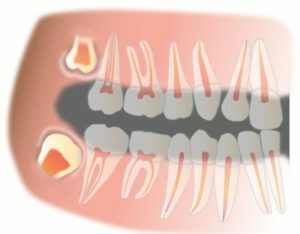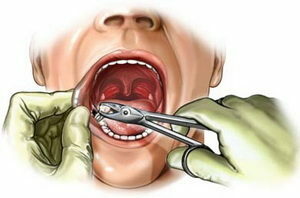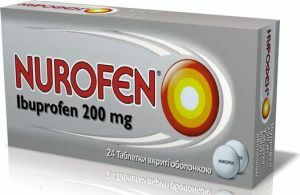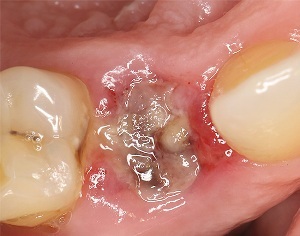 Removing wisdom teeth, the so-called "eight", always causes some concern. First, an uncomfortable location significantly complicates the operation.
Removing wisdom teeth, the so-called "eight", always causes some concern. First, an uncomfortable location significantly complicates the operation.
Secondly, wisdom teeth are most often subjected to retention and other pathologies.
Third, the eighth molars appear at the age when the gum is significantly thickened, which means that the postoperative period can be longer and more severe.
Contents of
- How does removal work?
- The gum is after the procedure - it's ok
- How much can the gum ache after tooth extraction?
- How long will the wound heal?
- How much does the edema persist?
How does the deletion occur?
Indications for the removal of the tooth are its retention, hood inflammation, root curvature, gum defects and other pathologies. So the removal of the wisdom tooth is initially accompanied by complicating factors.
 With minimal pathologies, the wisdom tooth is removed as follows:
With minimal pathologies, the wisdom tooth is removed as follows:
- is treated with an antiseptic;
- inject pain medication;
- extract tooth with special forceps.
With a strong curvature of the tooth, it can be removed in parts. To do this, the whole tooth is sawn into individual parts, which are extracted in stages. If the tooth does not completely come to the surface, an incision is made to open the gum.
In the presence of inflammation, antibacterial therapy is performed before the operation. After removal, anti-inflammatory drugs are prescribed. The damaged gum is sewn up, the wound is treated with an antiseptic. The patient is released home only after a complete stop of bleeding.
The features of wisdom tooth extraction are available and detailed on the video:
The gum ache after the procedure is normal.
Pain in the gums is a natural reaction after ejaculation, unfortunately, there is no painless removal of wisdom teeth.
With the termination of anesthesia, the patient has to deal with blunt aching pain, which usually releases a day after the operation.
How much can the gum ache after tooth extraction?
 In some cases, pain in the gums persists for a long time, and it adds to poor health, swelling, fever.
In some cases, pain in the gums persists for a long time, and it adds to poor health, swelling, fever.
This may indicate the development of inflammation. Shooting or throbbing pain indicates possible complications. It is necessary to consult a dentist and determine the cause that causes severe pain.
If the discomfort in the gums after the eighth molar is pulled out is a consequence of individual characteristics, the application of cold to the cheek will help ease the condition, rinsing with antiseptic decoctions of herbs: calendula, chamomile, oak bark.
In case of severe pain, an analgesic may be prescribed. As a rule, dentists prescribe "Ibuprofen" or "Ketanov".
How long will the wound heal?

Alveolitis - inflammation in the tooth socket after removal of
With a blood clot, the gum heals relatively quickly. When the clot is washed out, a so-called dry hole is formed, the healing of which is much more complicated.
First, because of the increased risk of infection and inflammation. Secondly, because of the hung sensitivity to mechanical influences.
The blood clot is completely replaced with tissue one week after the operation. This is how long the healing process takes, not aggravated by complications. The final appearance of the gum acquires after three to four months.
To reduce the impact on the wound, you should refrain from drinking alcohol, replace hot food with a warm, and hard products subject to pre-grinding.
How much does the edema persist?
 Usually edema appears after severe removal of "pomoshki".In some cases, it can be accompanied by a hematoma, which especially occurs when removing molars of the lower row. Edema can indicate the unremoved remains of the tooth, deep gum damage, allergic reactions to the applied anesthetics.
Usually edema appears after severe removal of "pomoshki".In some cases, it can be accompanied by a hematoma, which especially occurs when removing molars of the lower row. Edema can indicate the unremoved remains of the tooth, deep gum damage, allergic reactions to the applied anesthetics.
It is forbidden to apply heat to the cheek. With a strong swelling cold is used. Cold compresses do 3-4 times a day for 10-20 minutes.
The appearance of edema is promoted by heavy physical exertion. After the removal of the wisdom tooth, the patient needs a rest period, the duration of which should be at least three days.
 For quick healing and elimination of gingival edema, the following rinses are recommended:
For quick healing and elimination of gingival edema, the following rinses are recommended:
- soda solution;
- with furacilin;
- decoction of oak bark;
- propolis.
Rinse mouth in the first day after surgery is strictly prohibited. Instead of intense rinsing, you need to put the solution into your mouth, keep it for about a minute, then spit.
In the absence of complications, the swelling of the gum occurs within 2 days. Hematomas on the cheeks can persist for up to a week. Proper oral hygiene will help to significantly reduce the recovery period.
